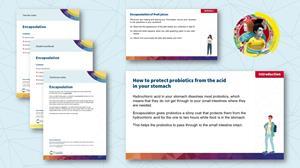Investigate encapsulation and the role it plays in helping probiotics travel to the gut
This activity should take approximately one hour to complete in full. It was initially created for 11–14 year-old learners but can be adapted for other age groups.
Use the resource in a sequence of timetabled lessons, science clubs or as part of an activity day. This experiment is best carried out in a domestic science lab or food technology classroom where learners can eat the fruit beads they make. Learners should not eat their beads if the activity is done in a lab with science equipment.
Learning objectives
- Describe the role of probiotics in the gut.
- Describe the need for encapsulation of probiotics.
Guidance notes
Use PowerPoint slides 3–7, including a video, to introduce probiotics and other uses of encapsulation.

This resource was developed as part of the Chemistry for All project. The project was set up to explore and address barriers to participation in UK chemistry undergraduate study through a longitudinal project. Read the findings relevant to teachers, outreach providers, education policymakers and parents in the summary report, or download the full research report.
Learners will make different coloured jelly beads using fruit juice, testing the variance between different juices and the effects of carbonated water on the beads. Learners can work individually or in pairs for this experiment.
Use slide 6 to describe the purposes of the two chemicals, sodium alginate and calcium lactate, used to encapsulate the juice in this experiment. Learners will place some of the beads into sparkling water and record their observations. Encourage your class to think about the causes of any changes they are observing.
Once learners have made one set of beads, encourage them to explore making different colours, shapes and sizes of beads to see which fruit juice is the best for making jelly beads. Learners should answer the questions in their student workbook as they prepare and test their jelly beads. Find the answers to the activity in the teacher notes and slides.
At the end of the activity, bring the learners back together and use slide 11 of the PowerPoint to discuss the expected observations and answers. Invite individuals to show their beads to the rest of the class.
Health and safety
Read our health and safety guidance and carry out a risk assessment before running any live practical.
The safety equipment suggested is in line with CLEAPSS requirements. For non-hazardous substances, wearing lab coats can help to protect clothes. The safety rules might be different where you live so it is worth checking local and school guidance.
More resources
- Investigate coatings on candies and other types of food with learners of all ages using this Edible experiments video.
- Introduce your learners to cross-linking polymers using sodium alginate in this practical experiment, with questions to check for understanding.
- Develop your 16–18 learners’ practical skills with a model, feedback, reapply loop using the Common Practical Assessment Criteria (CPAC) tracker, student peer assessment form and teacher notes.
- Watch this video of Richard talking about how his role as scientific leader uses technology to select compounds for new medicines.
Careers
The Chemistry for All project found that recognising the value and importance of chemistry, and appreciating how chemistry can lead to interesting and well-paid jobs strongly related to learners’ future aspirations.
Introduce learners to chemistry careers with our Making the Difference: changing lives video. Discover how chemistry can prepare learners to pursue apprenticeships, university courses and vocational routes, or browse job profiles and try our careers game from A Future in Chemistry too.
Find more activities like this, plus longer projects suitable for off-timetable days, science lessons or clubs on our Outreach resources hub.
Downloads
Encapsulation student workbook
Editable handout | Word, Size 0.47 mbEncapsulation student workbook
Handout | PDF, Size 0.42 mbEncapsulation teacher notes
Editable handout | Word, Size 0.48 mbEncapsulation teacher notes
Handout | PDF, Size 0.46 mbEncapsulation technician notes
Editable handout | Word, Size 0.47 mbEncapsulation technician notes
Handout | PDF, Size 0.39 mbEncapsulation presentation slides
Presentation | PowerPoint, Size 1.91 mbEncapsulation presentation slides
Presentation | PDF, Size 1.28 mb
Additional information
This resource was originally developed by the University of Reading to support outreach work delivered as part of the Chemistry for All project.



















No comments yet